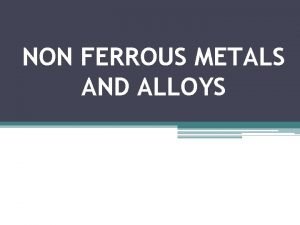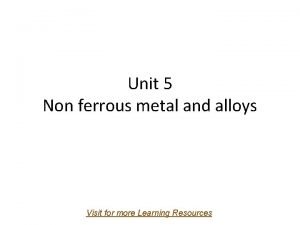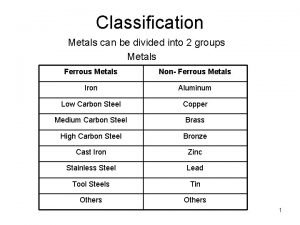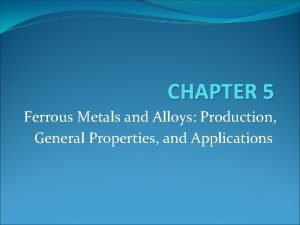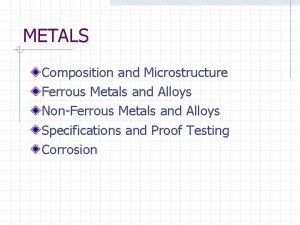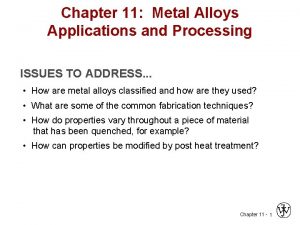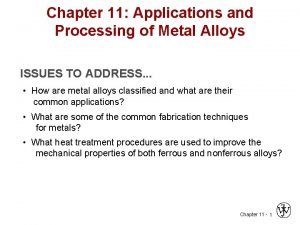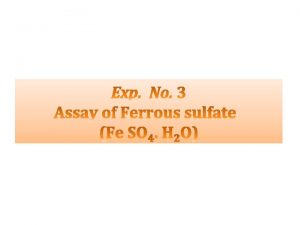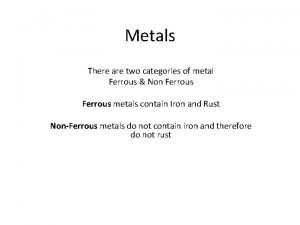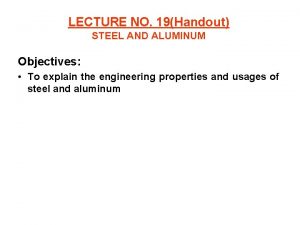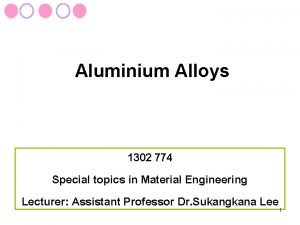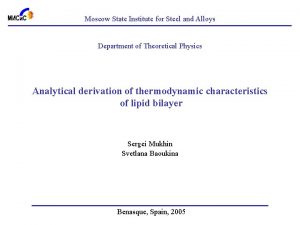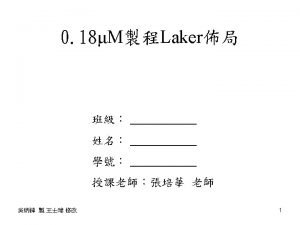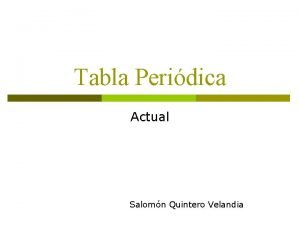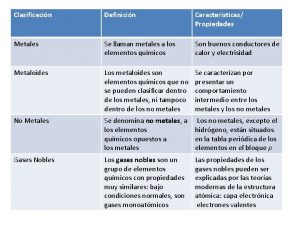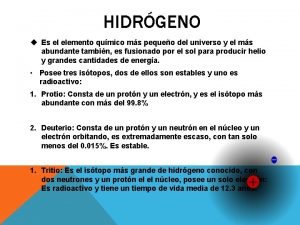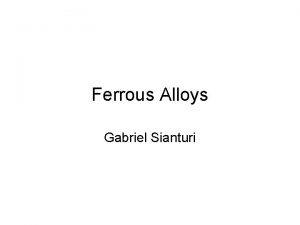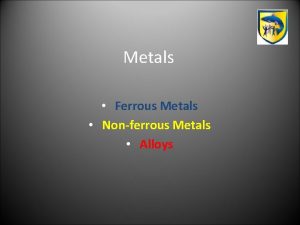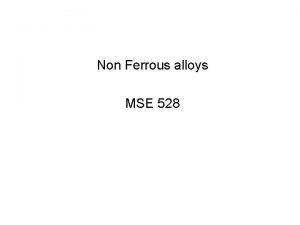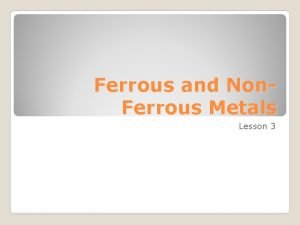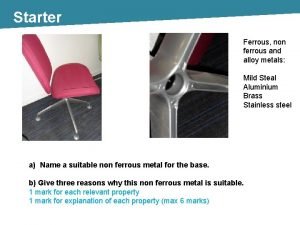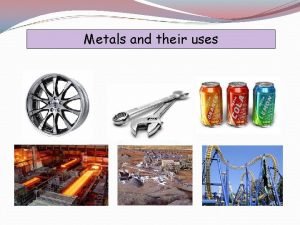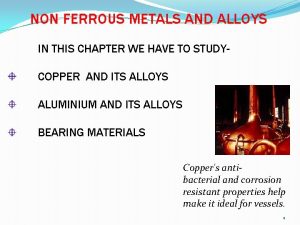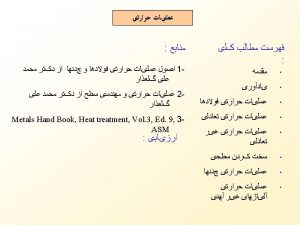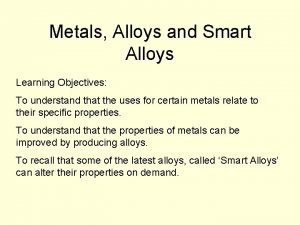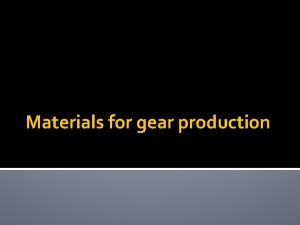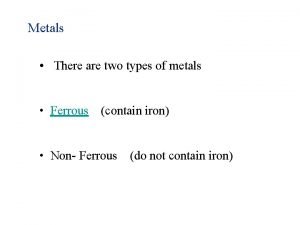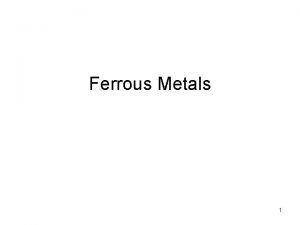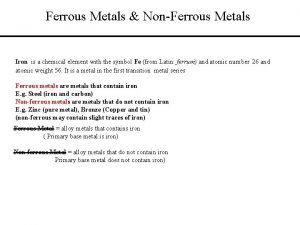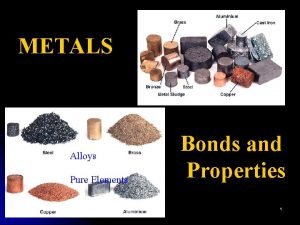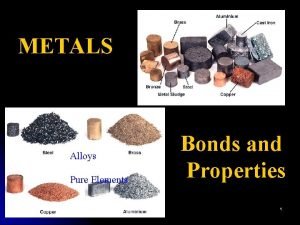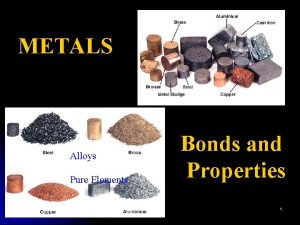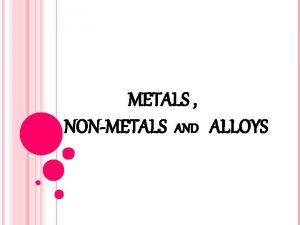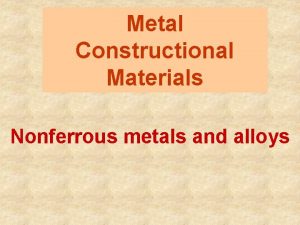Ferrous Metals 1 Pure Metals and Alloys Metal































- Slides: 31

Ferrous Metals 1

Pure Metals and Alloys Metal that are not mixed with any other materials are known as pure metals. Metals listed in the Periodic Table are pure metals E. g. Iron (Fe), Copper (Cu) and Zinc (Zn) Alloys are mixtures of two or more metals formed together with other elements/materials to create new metals with improved properties and characteristics. E. g. Brass (Copper and Zinc), Stainless steel (steel and chromium) Alloy = metal A + metal B + … + other elements 2

Ferrous Metals & Non-Ferrous Metals Ferrous metals are metals that contain iron E. g. Steel (iron and carbon) Non-ferrous metals are metals that do not contain iron E. g. Zinc (pure metal), Bronze (Copper and tin) (non-ferrous may contain slight traces of iron) Ferrous Metal = alloy metals that contains iron ( Primary base metal is iron) Non-ferrous Metal = alloy metals that do not contain iron Primary base metal does not contain iron) 3

Classification Metals can be divided into 2 groups Metals Ferrous Metals Non- Ferrous Metals Iron Aluminum Low Carbon Steel Copper Medium Carbon Steel Brass High Carbon Steel Bronze Cast Iron Zinc Stainless Steel Lead Tool Steels Tin Others 4

Ferrous Metals - Iron and Steel Pure iron is soft and ductile to be of much practical use. BUT when carbon is added, useful set of alloys are produced. They are known as carbon steel. The amount of carbon will determine the hardness of the steel. The carbon amount ranges from 0. 1% to 4%. 5

Types of Steel • Low carbon steel (mild steel) • Medium carbon steel • High carbon steel (tool steels) • Cast iron Alloy Steels • Stainless steel • High speed steel 6

Low Carbon Steel Also known as mild steel Contain 0. 05% -0. 32% carbon Tough, ductile and malleable Easily joined and welded Poor resistance to corrosion Often used a general purpose material Nails, screws, car bodies, Structural Steel used in the construction industry 7

Medium Carbon Steel Contains 0. 35% - 0. 5% of carbon Offer more strength and hardness BUT less ductile and malleable Structural steel, rails and garden tools 8

High Carbon Steel Also known as ‘tool steel’ Contain 0. 55%-1. 5% carbon Very hard but offers Higher Strength Less ductile and less malleable Hand tools (chisels, punches) Saw blades 9

Cast Iron Contains 2%-4% of carbon Very hard and brittle Strong under compression Suitable for casting [can be pour at a relatively low temperature] Engine block, engineer vices, machine parts 10

Cast Iron White: Hard and brittle, good wear resistance Uses: rolling & crunching Equipment Grey: Good compressive & tensile strength, machinability, and vibration-damping ability Uses: machine bases, crankshafts, furnace doors, Engine Blocks 11

Ductile: High strength and ductility Uses: engine and machine parts Malleable: Heat-treated version of white cast iron 12

Stainless Steel alloyed with chromium (18%), nickel (8%), magnesium (8%) Hard and tough Corrosion resistance Comes in different grades Sinks, cooking utensils, surgical instruments 13

Stainless Steels Main types: Ferritic chromium: very formable, relatively weak; used in architectural trim, kitchen range hoods, jewelry, decorations, utensils Grades 409, 430, and other 400 Austentitic nickel-chromium: non-magnetic, machinable, weldable, relatively weak; used in architectural products, such as fascias, curtain walls, storefronts, doors & windows, railings; chemical processing, food utensils, kitchen applications. series. Grades 301, 302, 303, 304, 316, and other 300 series. 14

Martensitic chromium: High strength, hardness, resistance to abrasion; used in turbine parts, bearings, knives, cutlery and generally Magnetic. Grades 17 -4, 410, 416, 420, 440 and other 400 series Maraging (super alloys): High strength, high Temperature alloy used in structural applications, aircraft components and are generally magnetic. Alloys containing around 18% Nickel. 15

High Speed Steel Medium Carbon steel alloyed with Tungsten, chromium, vanadium Very hard Resistant to frictional heat even at high temperature Can only be ground Machine cutting tools (lathe and milling) Drills 16

Heat Treatment A process used to alter the properties and characteristics of metals by heating and cooling. Cold working induce stress in metal lead to work hardening prevent further work from taking place Three stages of heat treatment 1. Heat the metal to the correct temperature 2. Keep it at that temperature for a the required length of time (soaking) 3. Cool it in the correct way to give the desired properties 17

Heat Treatment Types of heat treatment: Annealing Normalizing Hardening Tempering Case hardening 18

Annealing is the process whereby heat is introduced to mobilise the atoms and relieve internal stress After annealing, it allows the metal to be further shaped It involves the re-crystallization of the distorted structure 19

Normalizing This process is only confined to steel. It is used to refine the grain due to work hardening It involves the heating of the steel to just above Its upper critical point. Phase diagram of Iron-Carbon 20

Hardening is the process of increasing the hardness of steel by adding a high amount of carbon The degree of hardness depends on the amount of carbon present in steel and the form in which it is trapped during quenching. Once hardened, the steel is resistant to wear but is brittle and easily broken under load. 21

Tempering is the process to reduce hardness and brittleness slightly of a hardened steel workpiece. It helps to produce a more elastic and tough steel capable of retaining the cutting edge after tempering Prior to tempering, the steel must be cleaned to brightness with emery cloth so that oxide colour is visible when reheated Tempering temperature 1/α hardness Tempering temperature α toughness 22

Tempering Guidelines for tempering Tempering of cold chisel 230 C = 446 F 300 C = 572 F 23

Case Hardening Case hardening is a process used with mild steel to give a hard skin The metal is heated to cherry red and is dipped in Carbon powder. It is then repeated 2 -3 more times before Quenching the metal in water to harden the skin. This allows the surface of mild steel to be able to subject to wear but the soft core is able to subject to Sudden shock e. g. the tool holders 24

Case Hardening - Carburizing involves placing the mild steel in box packed with charcoal granules, heated to 950 º C (1742 o. F) and allowing the mild steel to soak for several hours. It achieves the same purpose of case hardening 25

Carbon Steels Used for Construciton • Those steels in which the residual elements (carbon, manganese, sulphur, silicon, etc. ) are controlled, but in which no alloying elements are added to achieve special properties.

A 36 Carbon Structural Steel • For years, the workhorse all-purpose steel for nearly all structural “shapes” (beams, channels, angles, etc. ), as well as plates and bars, has been:

Wide Flanged Beams “W” shapes • Recently (last few years), A 36 has been displaced as the steel of choice for the major “shape” subcategory called wideflange beams, or “W” shapes. The replacement steel is a high-strength, lowalloy steel, known as A 992 (see below). For the other non-wide-flange beam structural shapes, A 36 remains the predominant steel.

Structural pipe and square tubing • Pipe: A 53 Pipe, Steel, Black and Hot. Dipped, Zinc- Coated Welded and Seamless. • Tubing: A 500 Cold-Formed Welded and Seamless Structural Tubing in Rounds and Shapes. • A 501 Hot-Formed Welded and Seamless Carbon Steel Structural Tubing.

High-Strength, Low-Alloy Steels • • High-Strength, Low-Alloy Steels: A group of steels with chemical compositions specially developed to impart better mechanical properties and greater resistance to atmospheric corrosion than are obtainable from conventional carbon structural steels. Several particular steels used often in construction, and their ASTM specifications, are: • A 572: High-Strength, Low-Alloy Columbium-Vanadium Steels of Structural Quality. • A 618: Hot-Formed Welded and Seamless High-Strength, Low-Alloy Structural Tubing • • A 913: High-Strength, Low-Alloy Steel Shapes of Structural Quality, Produced by Quenching and Self-Tempering Process • A 992: Steel for Structural Shapes for Use in Building Framing This is the steel which has substantially replaced A 36 steel for Wide-flange structural shapes.

Corrosion – Resistant Steels • A 242: High-Strength, Low-Alloy Structural Steel. • A 588: High-Strength, Low-Alloy Structural Steel with 50 ksi Minimum Yield Point. • A 847: Cold-Formed Welded and Seamless High-Strength, Low-Alloy Structural Tubing with Improved Atmospheric Corrosion Resistance.
 Ferrous vs non ferrous
Ferrous vs non ferrous Ferrous material
Ferrous material 5 non ferrous metals
5 non ferrous metals Low carbon steel uses
Low carbon steel uses 5 ferrous metals
5 ferrous metals Microstructure of ferrous metals
Microstructure of ferrous metals Calister
Calister Applications and processing of metal alloys
Applications and processing of metal alloys What is the percent yield of ferrous sulfide
What is the percent yield of ferrous sulfide Ferrous scrap
Ferrous scrap Physical properties of ferrous sulphate
Physical properties of ferrous sulphate Categories of metals
Categories of metals Non metals in the periodic table
Non metals in the periodic table Metal and non metal
Metal and non metal Physical properties of materials grade 7
Physical properties of materials grade 7 Properties of materials grade 7
Properties of materials grade 7 Metal and non metal example
Metal and non metal example Difference between metal oxides and non metal oxides
Difference between metal oxides and non metal oxides Non metals melting and boiling points
Non metals melting and boiling points Non metals and uses
Non metals and uses Pure substance periodic table
Pure substance periodic table Metal and non metal definition
Metal and non metal definition Aluminum and its alloys
Aluminum and its alloys Aluminum and its alloys
Aluminum and its alloys Moscow institute of steel and alloys
Moscow institute of steel and alloys Venn diagram of conduction convection and radiation
Venn diagram of conduction convection and radiation Metal 1 metal 2
Metal 1 metal 2 Metals react with nonmetals to form ionic compounds by
Metals react with nonmetals to form ionic compounds by Grupo b tabla periódica
Grupo b tabla periódica Metaloides
Metaloides Electrones de valencia de francio
Electrones de valencia de francio Microfusion cast & alloys
Microfusion cast & alloys

